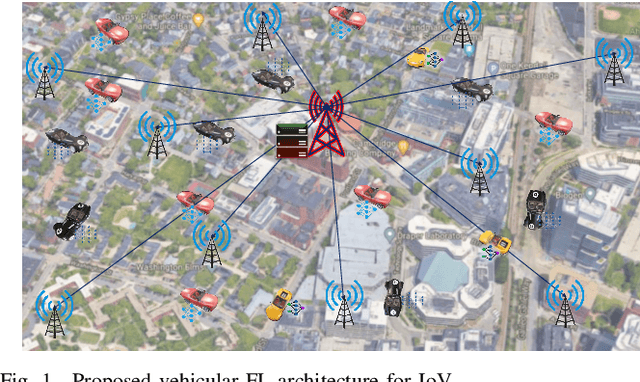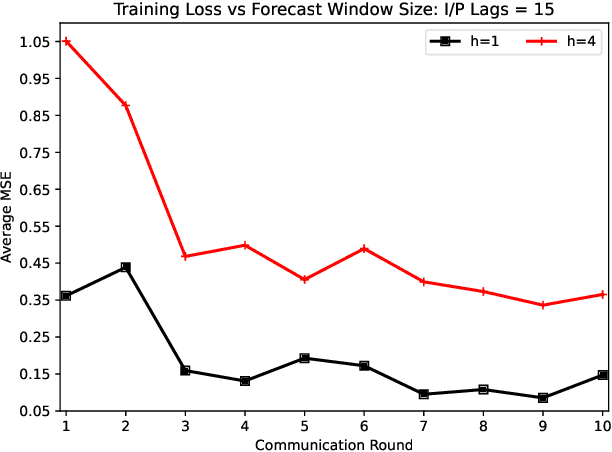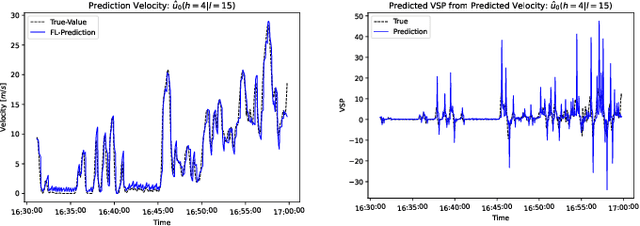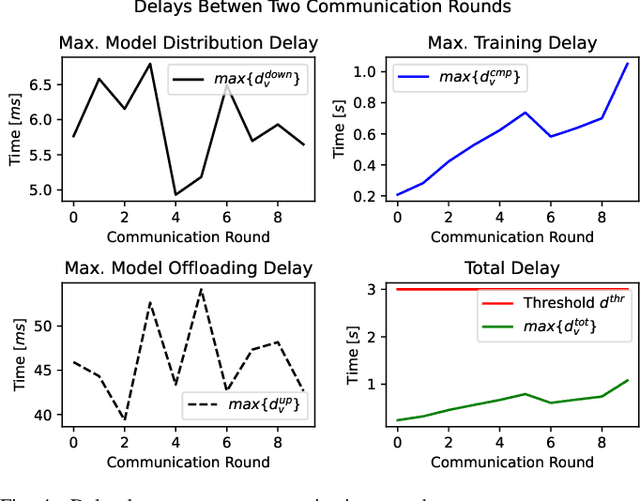Md Ferdous Pervej
Online-Score-Aided Federated Learning: Taming the Resource Constraints in Wireless Networks
Aug 12, 2024Abstract:While FL is a widely popular distributed ML strategy that protects data privacy, time-varying wireless network parameters and heterogeneous system configurations of the wireless device pose significant challenges. Although the limited radio and computational resources of the network and the clients, respectively, are widely acknowledged, two critical yet often ignored aspects are (a) wireless devices can only dedicate a small chunk of their limited storage for the FL task and (b) new training samples may arrive in an online manner in many practical wireless applications. Therefore, we propose a new FL algorithm called OSAFL, specifically designed to learn tasks relevant to wireless applications under these practical considerations. Since it has long been proven that under extreme resource constraints, clients may perform an arbitrary number of local training steps, which may lead to client drift under statistically heterogeneous data distributions, we leverage normalized gradient similarities and exploit weighting clients' updates based on optimized scores that facilitate the convergence rate of the proposed OSAFL algorithm. Our extensive simulation results on two different tasks -- each with three different datasets -- with four popular ML models validate the effectiveness of OSAFL compared to six existing state-of-the-art FL baselines.
Resource-Aware Hierarchical Federated Learning in Wireless Video Caching Networks
Feb 06, 2024Abstract:Backhaul traffic congestion caused by the video traffic of a few popular files can be alleviated by storing the to-be-requested content at various levels in wireless video caching networks. Typically, content service providers (CSPs) own the content, and the users request their preferred content from the CSPs using their (wireless) internet service providers (ISPs). As these parties do not reveal their private information and business secrets, traditional techniques may not be readily used to predict the dynamic changes in users' future demands. Motivated by this, we propose a novel resource-aware hierarchical federated learning (RawHFL) solution for predicting user's future content requests. A practical data acquisition technique is used that allows the user to update its local training dataset based on its requested content. Besides, since networking and other computational resources are limited, considering that only a subset of the users participate in the model training, we derive the convergence bound of the proposed algorithm. Based on this bound, we minimize a weighted utility function for jointly configuring the controllable parameters to train the RawHFL energy efficiently under practical resource constraints. Our extensive simulation results validate the proposed algorithm's superiority, in terms of test accuracy and energy cost, over existing baselines.
Resource-Aware Hierarchical Federated Learning for Video Caching in Wireless Networks
Nov 12, 2023Abstract:Video caching can significantly improve backhaul traffic congestion by locally storing the popular content that users frequently request. A privacy-preserving method is desirable to learn how users' demands change over time. As such, this paper proposes a novel resource-aware hierarchical federated learning (RawHFL) solution to predict users' future content requests under the realistic assumptions that content requests are sporadic and users' datasets can only be updated based on the requested content's information. Considering a partial client participation case, we first derive the upper bound of the global gradient norm that depends on the clients' local training rounds and the successful reception of their accumulated gradients over the wireless links. Under delay, energy and radio resource constraints, we then optimize client selection and their local rounds and central processing unit (CPU) frequencies to minimize a weighted utility function that facilitates RawHFL's convergence in an energy-efficient way. Our simulation results show that the proposed solution significantly outperforms the considered baselines in terms of prediction accuracy and total energy expenditure.
Hierarchical Federated Learning in Wireless Networks: Pruning Tackles Bandwidth Scarcity and System Heterogeneity
Aug 03, 2023



Abstract:While a practical wireless network has many tiers where end users do not directly communicate with the central server, the users' devices have limited computation and battery powers, and the serving base station (BS) has a fixed bandwidth. Owing to these practical constraints and system models, this paper leverages model pruning and proposes a pruning-enabled hierarchical federated learning (PHFL) in heterogeneous networks (HetNets). We first derive an upper bound of the convergence rate that clearly demonstrates the impact of the model pruning and wireless communications between the clients and the associated BS. Then we jointly optimize the model pruning ratio, central processing unit (CPU) frequency and transmission power of the clients in order to minimize the controllable terms of the convergence bound under strict delay and energy constraints. However, since the original problem is not convex, we perform successive convex approximation (SCA) and jointly optimize the parameters for the relaxed convex problem. Through extensive simulation, we validate the effectiveness of our proposed PHFL algorithm in terms of test accuracy, wall clock time, energy consumption and bandwidth requirement.
Resource Constrained Vehicular Edge Federated Learning with Highly Mobile Connected Vehicles
Oct 27, 2022Abstract:This paper proposes a vehicular edge federated learning (VEFL) solution, where an edge server leverages highly mobile connected vehicles' (CVs') onboard central processing units (CPUs) and local datasets to train a global model. Convergence analysis reveals that the VEFL training loss depends on the successful receptions of the CVs' trained models over the intermittent vehicle-to-infrastructure (V2I) wireless links. Owing to high mobility, in the full device participation case (FDPC), the edge server aggregates client model parameters based on a weighted combination according to the CVs' dataset sizes and sojourn periods, while it selects a subset of CVs in the partial device participation case (PDPC). We then devise joint VEFL and radio access technology (RAT) parameters optimization problems under delay, energy and cost constraints to maximize the probability of successful reception of the locally trained models. Considering that the optimization problem is NP-hard, we decompose it into a VEFL parameter optimization sub-problem, given the estimated worst-case sojourn period, delay and energy expense, and an online RAT parameter optimization sub-problem. Finally, extensive simulations are conducted to validate the effectiveness of the proposed solutions with a practical 5G new radio (5G-NR) RAT under a realistic microscopic mobility model.
Mobility, Communication and Computation Aware Federated Learning for Internet of Vehicles
May 17, 2022



Abstract:While privacy concerns entice connected and automated vehicles to incorporate on-board federated learning (FL) solutions, an integrated vehicle-to-everything communication with heterogeneous computation power aware learning platform is urgently necessary to make it a reality. Motivated by this, we propose a novel mobility, communication and computation aware online FL platform that uses on-road vehicles as learning agents. Thanks to the advanced features of modern vehicles, the on-board sensors can collect data as vehicles travel along their trajectories, while the on-board processors can train machine learning models using the collected data. To take the high mobility of vehicles into account, we consider the delay as a learning parameter and restrict it to be less than a tolerable threshold. To satisfy this threshold, the central server accepts partially trained models, the distributed roadside units (a) perform downlink multicast beamforming to minimize global model distribution delay and (b) allocate optimal uplink radio resources to minimize local model offloading delay, and the vehicle agents conduct heterogeneous local model training. Using real-world vehicle trace datasets, we validate our FL solutions. Simulation shows that the proposed integrated FL platform is robust and outperforms baseline models. With reasonable local training episodes, it can effectively satisfy all constraints and deliver near ground truth multi-horizon velocity and vehicle-specific power predictions.
Vehicular Network Slicing for Reliable Access and Deadline-Constrained Data Offloading: A Multi-Agent On-Device Learning Approach
Dec 31, 2020



Abstract:Efficient data offloading plays a pivotal role in computational-intensive platforms as data rate over wireless channels is fundamentally limited. On top of that, high mobility adds an extra burden in vehicular edge networks (VENs), bolstering the desire for efficient user-centric solutions. Therefore, unlike the legacy inflexible network-centric approach, this paper exploits a software-defined flexible, open, and programmable networking platform for an efficient user-centric, fast, reliable, and deadline-constrained offloading solution in VENs. In the proposed model, each active vehicle user (VU) is served from multiple low-powered access points (APs) by creating a noble virtual cell (VC). A joint node association, power allocation, and distributed resource allocation problem is formulated. As centralized learning is not practical in many real-world problems, following the distributed nature of autonomous VUs, each VU is considered an edge learning agent. To that end, considering practical location-aware node associations, a joint radio and power resource allocation non-cooperative stochastic game is formulated. Leveraging reinforcement learning's (RL) efficacy, a multi-agent RL (MARL) solution is proposed where the edge learners aim to learn the Nash equilibrium (NE) strategies to solve the game efficiently. Besides, real-world map data, with a practical microscopic mobility model, are used for the simulation. Results suggest that the proposed user-centric approach can deliver remarkable performances in VENs. Moreover, the proposed MARL solution delivers near-optimal performances with approximately 3% collision probabilities in case of distributed random access in the uplink.
Artificial Intelligence Assisted Collaborative Edge Caching in Small Cell Networks
May 16, 2020

Abstract:Edge caching is a new paradigm that has been exploited over the past several years to reduce the load for the core network and to enhance the content delivery performance. Many existing caching solutions only consider homogeneous caching placement due to the immense complexity associated with the heterogeneous caching models. Unlike these legacy modeling paradigms, this paper considers heterogeneous (1) content preference of the users and (2) caching models at the edge nodes. Besides, collaboration among these spatially distributed edge nodes is used aiming to maximize the cache hit ratio (CHR) in a two-tier heterogeneous network platform. However, due to complex combinatorial decision variables, the formulated problem is hard to solve in the polynomial time. Moreover, there does not even exist a ready-to-use tool or software to solve the problem. Thanks to artificial intelligence (AI), based on the methodologies of the conventional particle swarm optimization (PSO), we propose a modified PSO (M-PSO) to efficiently solve the complex constraint problem in a reasonable time. Using numerical analysis and simulation, we validate that the proposed algorithm significantly enhances the CHR performance when comparing to that of the existing baseline caching schemes.
 Add to Chrome
Add to Chrome Add to Firefox
Add to Firefox Add to Edge
Add to Edge